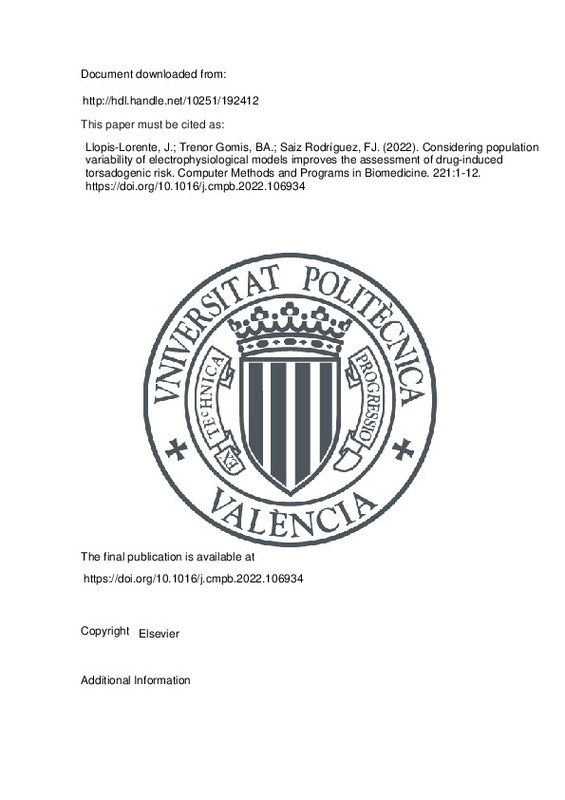JavaScript is disabled for your browser. Some features of this site may not work without it.
Buscar en RiuNet
Listar
Mi cuenta
Estadísticas
Ayuda RiuNet
Admin. UPV
Considering population variability of electrophysiological models improves the assessment of drug-induced torsadogenic risk
Mostrar el registro sencillo del ítem
Ficheros en el ítem
| dc.contributor.author | Llopis-Lorente, Jordi
|
es_ES |
| dc.contributor.author | Trenor Gomis, Beatriz Ana
|
es_ES |
| dc.contributor.author | Saiz Rodríguez, Francisco Javier
|
es_ES |
| dc.date.accessioned | 2023-03-07T19:01:06Z | |
| dc.date.available | 2023-03-07T19:01:06Z | |
| dc.date.issued | 2022-06 | es_ES |
| dc.identifier.issn | 0169-2607 | es_ES |
| dc.identifier.uri | http://hdl.handle.net/10251/192412 | |
| dc.description.abstract | [EN] Background and Objective In silico tools are known to aid in drug cardiotoxicity assessment. However, computational models do not usually consider electrophysiological variability, which may be crucial when predicting rare adverse events such as drug-induced Torsade de Pointes (TdP). In addition, classification tools are usually binary and are not validated using an external data set. Here we analyze the role of incorporating electrophysiological variability in the prediction of drug-induced arrhythmogenic-risk, using a ternary classification and two external validation datasets. Methods The effects of the 12 training CiPA drugs were simulated at three different concentrations using a single baseline model and an electrophysiologically calibrated population of models. 9 biomarkers related with action potential (AP), calcium dynamics and net charge were measured for each simulated concentration. These biomarkers were used to build ternary classifiers based on Support Vector Machines (SVM) methodology. Classifiers were validated using two external drug sets: the 16 validation CiPA drugs and 81 drugs from CredibleMeds database. Results Population of models allowed to obtain different AP responses under the same pharmacological intervention and improve the prediction of drug-induced TdP with respect to the baseline model. The classification tools based on population of models achieve an accuracy higher than 0.8 and a mean classification error (MCE) lower than 0.3 for both validation drug sets and for the two electrophysiological action potential models studied (Tomek et al. 2020 and a modified version of O'Hara et al. 2011). In addition, simulations with population of models allowed the identification of individuals with lower conductances of IKr, IKs, and INaK and higher conductances of ICaL, INaL, and INCX, which are more prone to develop TdP. Conclusions The methodology presented here provides new opportunities to assess drug-induced TdP-risk, taking into account electrophysiological variability and may be helpful to improve current cardiac safety screening methods. | es_ES |
| dc.description.sponsorship | This project has received funding from the European Union's Horizon 2020 research and innovation program under grant agreement No 101016496 (SimCardioTest). This workwas alsopartially supported by the Direccion General de Politica Cientifica de la Generalitat Valenciana (PROMETEO/2020/043). JL is being funded by the Ministerio de Ciencia, Innovacion y Universidades for the Formacion de Profesorado Universitario (grant reference: FPU18/01659). Funding for open access charge: Universitat Politecnica de Valencia. | es_ES |
| dc.language | Inglés | es_ES |
| dc.publisher | Elsevier | es_ES |
| dc.relation.ispartof | Computer Methods and Programs in Biomedicine | es_ES |
| dc.rights | Reconocimiento - No comercial - Sin obra derivada (by-nc-nd) | es_ES |
| dc.subject | In-silico | es_ES |
| dc.subject | Proarrhythmic-risk | es_ES |
| dc.subject | Torsade de Pointes | es_ES |
| dc.subject | Cardiac safety | es_ES |
| dc.subject | Population of models | es_ES |
| dc.subject.classification | TECNOLOGIA ELECTRONICA | es_ES |
| dc.title | Considering population variability of electrophysiological models improves the assessment of drug-induced torsadogenic risk | es_ES |
| dc.type | Artículo | es_ES |
| dc.identifier.doi | 10.1016/j.cmpb.2022.106934 | es_ES |
| dc.relation.projectID | info:eu-repo/grantAgreement/EC/H2020/101016496/EU | es_ES |
| dc.relation.projectID | info:eu-repo/grantAgreement/ //FPU18%2F01659//AYUDA PREDOCTORAL FPU-LLOPIS LORENTE. PROYECTO: DESARROLLO DE MODELOS MULTI-ESCALA DE CORAZON HUMANO Y HERRAMIENTAS COMPUTACIONALES PARA LA EVALUACION DE LA CARDIOTOXICIDAD DE FARMACOS EN CONDICIONES SANAS Y DE INSUFICIENCIA CARDIACA/ | es_ES |
| dc.relation.projectID | info:eu-repo/grantAgreement/GENERALITAT VALENCIANA//PROMETEO%2F2020%2F043//MODELOS IN-SILICO MULTI-FISICOS Y MULTI-ESCALA DEL CORAZON PARA EL DESARROLLO DE NUEVOS METODOS DE PREVENCION, DIAGNOSTICO Y TRATAMIENTO EN MEDICINA PERSONALIZADA (HEART IN-SILICO MODELS)/ | es_ES |
| dc.rights.accessRights | Abierto | es_ES |
| dc.contributor.affiliation | Universitat Politècnica de València. Escuela Técnica Superior de Ingeniería del Diseño - Escola Tècnica Superior d'Enginyeria del Disseny | es_ES |
| dc.contributor.affiliation | Universitat Politècnica de València. Escuela Técnica Superior de Ingenieros Industriales - Escola Tècnica Superior d'Enginyers Industrials | es_ES |
| dc.description.bibliographicCitation | Llopis-Lorente, J.; Trenor Gomis, BA.; Saiz Rodríguez, FJ. (2022). Considering population variability of electrophysiological models improves the assessment of drug-induced torsadogenic risk. Computer Methods and Programs in Biomedicine. 221:1-12. https://doi.org/10.1016/j.cmpb.2022.106934 | es_ES |
| dc.description.accrualMethod | S | es_ES |
| dc.relation.publisherversion | https://doi.org/10.1016/j.cmpb.2022.106934 | es_ES |
| dc.description.upvformatpinicio | 1 | es_ES |
| dc.description.upvformatpfin | 12 | es_ES |
| dc.type.version | info:eu-repo/semantics/publishedVersion | es_ES |
| dc.description.volume | 221 | es_ES |
| dc.identifier.pmid | 35687995 | es_ES |
| dc.relation.pasarela | S\467292 | es_ES |
| dc.contributor.funder | GENERALITAT VALENCIANA | es_ES |
| dc.contributor.funder | COMISION DE LAS COMUNIDADES EUROPEA | es_ES |
| dc.contributor.funder | Universitat Politècnica de València | es_ES |
| dc.contributor.funder | MINISTERIO DE CIENCIA INNOVACION Y UNIVERSIDADES | es_ES |
| dc.subject.ods | 03.- Garantizar una vida saludable y promover el bienestar para todos y todas en todas las edades | es_ES |







![[Cerrado]](/themes/UPV/images/candado.png)

